Landing craft
Landing craft are small and medium seagoing
Because of the need to run up onto a suitable beach, World War II landing craft were flat-bottomed, and many designs had a flat front, often with a lowerable ramp, rather than a normal
History
In the days of sail, the ship's boats were used as landing craft. These rowing boats were sufficient, if inefficient, in an era when
In order to support amphibious operations during the
Origins
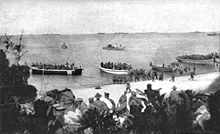
During World War I, the mass mobilization of troops equipped with rapid-fire weapons quickly rendered such boats obsolete. Initial landings during the Gallipoli campaign took place in unmodified rowing boats that were extremely vulnerable to attack from the Turkish shore defenses.
In February 1915, orders were placed for the design of purpose built landing craft. A design was created in four days resulting in an order for 200 'X' Lighters with a
The first use took place after they had been towed to the Aegean and performed successfully in the 6 August landing at Suvla Bay of IX Corps, commanded by Commander Edward Unwin.
'X' Lighters, known to the soldiers as 'Beetles', carried about 500 men, displaced 135 tons and were based on
The
Spain purchased 26-28 X-Lighters. During the Rif War, they were used in the Alhucemas landing, arguably the first major amphibious landing in which tanks were disembarked in large numbers.[3]
During the
Despite this outlook, the British produced the
It weighed 16 tons and had a box-like appearance, having a square bow and stern. To prevent fouling of the propellers in a craft destined to spend time in surf and possibly be beached, a crude waterjet propulsion system was devised by White's designers. A Hotchkiss petrol engine drove a centrifugal pump which produced a jet of water, pushing the craft ahead or astern, and steering it, according to how the jet was directed. Speed was 5-6 knots and its beaching capacity was good.[6] By 1930, three MLC were operated by the Royal Navy.
The United States revived and experimented in
In 1939, during the annual Fleet Landing Exercises, the FMF became interested in the military potential of Andrew Higgins's design of a powered, shallow-draught boat. These LCPL, dubbed the 'Higgins Boats', were reviewed and passed by the U.S. Naval Bureau of Construction and Repair. Soon, the Higgins boats were developed to a final design with a ramp – the LCVP, and were produced in large numbers. The boat was a more flexible variant of the LCPR with a wider ramp. It could carry 36 troops, a small vehicle such as a jeep, or a corresponding amount of cargo.
Second World War
Specialized infantry landing craft
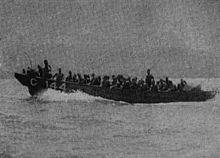

In the run-up to WWII, many specialized landing craft, both for infantry and vehicles, were developed. At the start of World War II, the Japanese led the world in landing craft design.[8]
The
In November 1938, the British
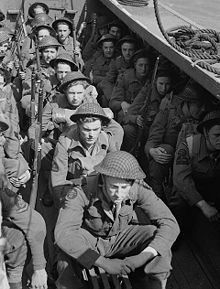
J. S. White of Cowes built a prototype to the Fleming design.[12] Eight weeks later the craft was doing trials on the River Clyde. All landing craft designs must find a compromise between two divergent priorities; the qualities that make a good sea boat are opposite to those that make a craft suitable for beaching.[13] The craft had a hull built of double-diagonal mahogany planking. The sides were plated with "10lb. DIHT" armour, a heat treated steel based on D1 steel,[14] in this case Hadfield's Resista 1⁄4.[15]
The
The Landing Craft Infantry was a stepped up amphibious assault ship, developed in response to a British request for a vessel capable of carrying and landing substantially more troops than the smaller Landing Craft Assault (LCA). The result was a small steel ship that could land 200 troops, traveling from rear bases on its own bottom at a speed of up to 15 knots (28 km/h; 17 mph). The original British design was envisioned as being a "one time use" vessel which would simply ferry the troops across the English Channel, and were considered an expendable vessel. As such, no troop sleeping accommodations were placed in the original design. This was changed shortly after initial use of these ships, when it was discovered that many missions would require overnight accommodations.
The first LCI(L)s entered service in 1943 chiefly with the Royal Navy (RN) and United States Navy. Some 923 LCI were built in ten American shipyards and 211 provided under lend-lease to the Royal Navy.
Specialized vehicle landing craft

Following the
Design work began at John I. Thornycroft Ltd. in May 1938 with trials completing in February 1940.[6] Constructed of steel and selectively clad with armour plate, this shallow-draft, barge-like boat with a crew of 6, could ferry a tank of 16 long tons to shore at 7 knots (13 km/h). Depending on the weight of the tank to be transported the craft might be lowered into the water by its davits already loaded or could have the tank placed in it after being lowered into the water.

Although the Royal Navy had the
The first LCT Mark 1 was launched by

The Mark 3 had an additional 32-foot (9.8 m) midsection that gave it a length of 192 feet (59 m) and a displacement of 640 tons. Even with this extra weight, the vessel was slightly faster than the Mark 1. The Mk.3 was accepted on 8 April 1941. The Mark 4 was slightly shorter and lighter than the Mk.3, but had a much wider beam (38 ft 9 in (11.81 m)) and was intended for cross channel operations as opposed to seagoing use. When tested in early assault operations, like the ill-fated Allied raid on Dieppe in 1942, the lack of manoeuvring ability led to the preference for a shorter overall length in future variants, most of which were built in the United States.
When the United States entered the war in December 1941, the U.S. Navy had no amphibious vessels at all, and found itself obliged to consider British designs already in existence. One of these, advanced by K.C. Barnaby of Thornycroft, was for a double-ended LCT to work with landing ships. The Bureau of Ships quickly set about drawing up plans for landing craft based on Barnaby's suggestions, although with only one ramp. The result, in early 1942, was the LCT Mark 5, a 117-foot (36 m) craft that could accommodate five 30-ton or four 40-ton tanks or 150 tons of cargo. This 286-ton landing craft could be shipped to combat areas in three separate water-tight sections aboard a cargo ship or carried pre-assembled on the flat deck of a Landing Ship, Tank (LST). The Mk.5 would be launched by heeling the LST on its beam to let the craft slide off its chocks into the sea, or cargo ships could lower each of the three sections into the sea where they were joined together.[19]
Development of Landing Ships
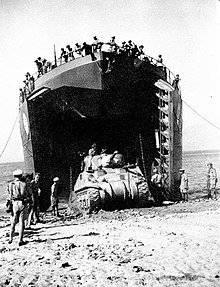
A further development was the
In November 1941, a small delegation from the British Admiralty arrived in the United States to pool ideas with the United States Navy's Bureau of Ships with regard to development of ships and also including the possibility of building further Boxers in the US.[20] During this meeting, it was decided that the Bureau of Ships would design these vessels. The LST(2) design incorporated elements of the first British LCTs from their designer, Sir Rowland Baker, who was part of the British delegation. This included sufficient buoyancy in the ships' sidewalls that they would float even with the tank deck flooded.[21] The LST(2) gave up the speed of HMS Boxer at only 10 knots but had a similar load while drawing only 3 feet forward when beaching.
Congress provided the authority for the construction of LSTs along with a host of other auxiliaries, destroyer escorts, and assorted landing craft. The enormous building program quickly gathered momentum. Such a high priority was assigned to the construction of LSTs that the previously laid keel of an aircraft carrier was hastily removed to make room for several LSTs to be built in her place. The keel of the first LST was laid down on 10 June 1942 at Newport News, Va., and the first standardized LSTs were floated out of their building dock in October. Twenty-three were in commission by the end of 1942. Lightly armored, they could steam cross the ocean with a full load on their own power, carrying infantry, tanks and supplies directly onto the beaches. Together with 2,000 other landing craft, the LSTs gave the troops a protected, quick way to make combat landings, beginning in summer 1943.[22]
Other

Nine-ton Landing Craft Navigation (LCN) were used by British "Combined Operations Assault Pilotage Parties" (
Landing Craft Control (LCC)
The Landing Craft Control (LCC) were 56-foot (17 m)
Very small landing craft, or amphibians, were designed. The U.S.-designed Landing Vehicle Tracked, was an amphibious (and sometimes armored) personnel carrier. These were operated by Army personnel, not naval crews and had a capacity of about three tons. The British introduced their own amphibian, the Terrapin.
Landing Craft Utility (LCU)
A Landing Craft Utility (LCU) was used to transport equipment and troops to the shore. It was capable of transporting tracked or wheeled vehicles and troops from amphibious assault ships to beachheads or piers.

The
The design was developed and built in the US for the USN and the Royal Navy. The LSD could carry 36 LCM at 16 knots. It had a large open compartment at the back. Opening a stern door and flooding special compartments opened this area to the sea so that LCI-sized vessels could enter or leave. It took one and a half hours for the dock to be flooded down and two and half to pump it out. When flooded they could also be used as docks for repairs to small craft.
Due to their small size, most amphibious ships were not given names and were just given serial numbers, e.g., LCT 304. The LSTs were an exception to this, since they were similar in size to a small cruiser. In addition, three British-built LSTs were named: HMS Boxer, HMS Bruiser and HMS Thruster; these were all larger than the U.S. design and had proper funnels.
Special craft
It was soon realized that battleships, cruisers and destroyers could not necessarily provide all the fire support (including suppressive fire) that an amphibious assault might need.[citation needed] Therefore, specialized vessels were developed that incorporated various direct and indirect fire weapons. These included guns and rockets which could be mounted on landing craft and landing ships. As part of the final barrage before an assault, the landing area would be plastered by these types.
Amphibious landing craft of WWII were generally fitted out with minimal weaponry.
LCIs and LCTs carried heavier weapons, such as the Oerlikon 20 mm cannon, on each side of the bridge structure. LSTs had a somewhat heavier armament.
Some landing craft were converted for special purposes either to provide defence for the other landing craft in the attack or as support weapons during the landing.
Landing Craft Assault (Hedgerow)
The LCA(HR) was a converted British LCA. It carried a battery of 24
Three flotillas (of 18, 18 and 9 craft) were used at Juno, Gold and Sword beaches.[25]
Landing Craft Flak
The Landing Craft Flak (LCF) was a conversion of the LCT that was intended to give
Landing Craft Gun

The
Landing Craft Rocket

The
The method of operation was to anchor off the target beach, pointing towards the shore. The distance to the shore was then measured by radar and the elevation of the launchers set accordingly. The crew then vanished below (apart from the commanding officer who retreated to a special cubby hole to control things) and the launch was then set off electrically. The launch could comprise the entire set or individual ranks of rockets.[27]
A full reload was a very labor-intensive operation and at least one LCT(R) went alongside a cruiser and got a working party from the larger ship to assist in the process.
Landing Craft Support

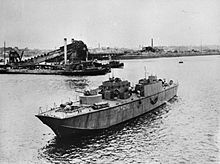
The Landing Craft Support was used to give some firepower close in.
The Landing Craft Support (Medium) (LCS(M)), Mark 2 and Mark 3 were used by the British forces at Normandy. The crew was Royal Navy, with Royal Marines to operate the weapons: two 0.5 inch Vickers machine guns and a 4-inch mortar to fire smoke shells.
The
The American Landing Craft Support was larger, each was armed with a 3-inch gun (7.6 cm), various smaller guns, and ten MK7 rocket launchers.
Inflatable landing craft
The first and last instances of the large use of rubber boats in amphibious operations in World War II were the
Landing Craft Group and wartime training
After Pearl Harbor, the U.S. Army and Navy began intense planning for the transport of millions of men into combat and the training for amphibious operations. By June 1942, Amphibious Force, Atlantic Fleet (AFAF) established headquarters at Norfolk (Virginia) under the command of Admiral Henry Kent Hewitt. Temporary headquarters for a transport command were set up in an old American Export Line transport ship that had been built for the Army in World War I.[30]: 66–67 Within the transport command, a Landing Craft Group was created to prepare the crews of landing ships.
"The training of landing craft crews under the direction of Captain
To man and support such landing craft, the Navy ordered that 30,000 men and 3,000 officers be trained in a matter of months, but initially the Landing Craft Group consisted only of Capt. Clarke, two officers and a yeoman. In creating training programs, Clarke studied blueprints for the new craft and "from these paper drawings he prepared ship's organizations for each type. This was the first textbook for crews assigned to the large landing craft. From this, they were to be trained in what their duties were to be, what the ship would be like, and how it would be expected to operate."[30]: 67
In August 1942, Capt. Clarke was told about Operation Torch and secret plans to invade North Africa the following November. He had only a few months to train thousands of men, most of whom were just out of indoctrination school. "They were the butchers, the bakers, and the light bulb makers of American youth. War was new to them, and organized Navy life was strange," observed Lt. Eric Burton, a Naval officer who wrote By Sea and by Land, a semi-official account published during the War about amphibious combat.[30]
Capt. Clarke created hydrographic, maintenance, medical, and communications training programs, and a section to train Army shore parties how to unload landing craft. He set up a training facility at Solomons Island, and held exercises on the shores of the Chesapeake Bay around the clock, day and night.
On 1 September 1942, the Amphibious Force and its Landing Craft Group rented the Nansemond Hotel, a popular resort hotel on Virginia Beach near Norfolk, to use as a headquarters building. Eventually, 40 major amphibious operations would be planned at the old hotel. For several weeks, Gen. George S. Patton worked on plans for the invasion of North Africa out of the Nansemond.[32]
"Captain Clarke had less than two months, about one-third of what had been considered the minimum, to train these men to conduct night ship-to-shore landings," wrote Samuel Eliot Morison about the preparations for Operation Torch. "Considering the time limitations, his performance was remarkable."[31] Clarke was awarded the Legion of Merit for the accomplishment. According to the Presidential citation, he and the Landing Craft Group "brought these ships and craft to a high state of readiness for combat operations in all subsequent major amphibious operations in the Atlantic, Pacific, and Mediterranean theatres.[33]
Early Cold War developments
Despite all the progress that was seen during World War II, there were still fundamental limitations in the types of coastline that were suitable for assault. Beaches had to be relatively free of obstacles, and have the right tidal conditions and the correct slope. However, the development of the helicopter fundamentally changed the equation.
The first use of helicopters in an amphibious assault came during the
The US Navy built five
Current landing craft
Amphibious mechanized utility and landing craft
Mechanized utility and landing craft were the kind used during the second world war and, while the mechanized landing craft of today are similar in construction, many improvements have been made. For example, landing craft (such as the
Air-cushioned landing craft
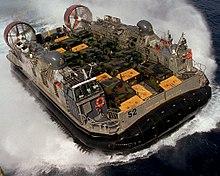
The air-cushioned landing craft (Landing Craft Air Cushion, or LCAC in the US Navy) is based on small to mid-sized multi-purpose hovercraft, Also known as "over the beach" ("OTB") craft, they allow troops and material to access more than 70 percent of the world's coastline, while only approximately 15 percent of that coastline is available to conventional landing craft. Like the mechanized landing craft, they are usually equipped with mounted machine guns, although they also support grenade launchers and heavy weapons. These vehicles are commonly used in the United States Navy, the Royal Navy, the Russian Navy, and the Hellenic Navy.
Landing barges
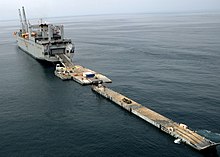
Landing barges were adaptations of British
Some were fitted with engines, while others were towed to the beach. They were used for defence, transportation, supply (food, water and oil) and repair (fitted out with workshops).
Those fitted for vehicle carrying had a ramp fitted in place at the rear and they had to back onto beaches. They would work from ships and coasters to the shore and back.
Two flotillas were made up of "flak barges" to provide defence of the beaches. Like landing craft, flak barges carried A/A guns: two
The Landing Barge, Kitchen (LBK) was fitted with a large superstructure containing the galley. With a crew of 20 plus, they could carry food for 800 for a week and provide 1,600 hot and 800 cold meals a day, including freshly baked bread.[34]
See also
Notes
- ISBN 978-1-4357-1183-9.
- ^ Fletcher, D British Mark IV tank New Vanguard, Osprey Publishing [page needed]
- ^ Ash, John (29 October 2020). "X-Lighter Motor Landing Craft". Weapons of War. Retrieved 22 April 2024 – via Key Military.
- ISBN 1-55750-152-1
- ISBN 1-84067-533-0
- Buffetaut, Yves D-Day Ships, Naval Institute Press, Annapolis, Maryland, 1994. ISBN 1-55750-152-1, p. 11
- Buffetaut, Yves D-Day Ships, Naval Institute Press, Annapolis, Maryland, 1994.
- ^ a b Fergusson, Bernard The Watery Maze; the story of Combined Operations, Holt, New York, 1961. pp. 38-43
- ^ Allan R. Millett, "Semper Fidelis: The History of the United States Marine Corps", (New York City, NY: The Free Press, 1991). [page needed]
- ^ JSTOR 4233491.
- ISSN 0362-4331. Retrieved 28 December 2020.
- OCLC 711183714, retrieved 28 December 2020
- ^ a b c Maund, LEH. Assault From the Sea, Methuen & Co. Ltd., London 1949. pp. 3–10
- ^ Buffetaut, p. 26
- ^ Saunders 1943, p. 11.
- ^ Welding & Fabrication of Ships Structure Archived 6 July 2001 at the Wayback Machine MOD
- ^ Buffetaut 1994, p. 49
- ^ Bruce, p. 10
- ^ Ladd, 1976, p.42
- ^ a b "Landing Craft, Tank (LCT)". globalsecurity.org. Retrieved 17 January 2011.
- ^ a b Basil Hearde. "The Tin Armada: Saga of the LCT". ww2lct.org. Archived from the original on 2 September 2011. Retrieved 15 January 2011.
- ISBN 0-85177-675-2, p.143
- ^ Brown, D.K. p.143
- ^ Isely and Crowl, The U.S. Marines and Amphibious War Its Theory and Its Practice in the Pacific (1951) ch 3 [page needed]
- ^ "Accessed 18 March 2008". Combinedops.com. 9 March 1943. Retrieved 10 May 2009.
- ^ US Navy ONI 226 Allied Landing Craft and Ships, US Government Printing Office, 1944.[page needed]
- ^ "Major Landing Craft of World War II". The Royal Marines Museum. 6 October 2011. Archived from the original on 9 June 2014. Retrieved 7 October 2011.
- ^ Brown, D K. Nelson to Vanguard. p. 145.
- ^ British Landing Craft of World War II Naval Historical Society
- ^ "US Navy Small Landing Craft, 1940–1945". Ibiblio.org. 25 May 2006. Retrieved 10 May 2009.
- ^ p. 46 Jablon, Howard David M. Shoup: A Warrior Against War Rowman & Littlefield, 1 Jan 2005
- ^ ISBN 1406756555.
- ^ ISBN 1591145481.
- ^ "Old Nansemond Hotel, Ocean View Norfolk, Virginia". Wikimapia. Retrieved 29 July 2015.
- ^ "William Price Oliver Clarke". Information Bulletin (336). Bureau of Naval Personnel. March 1945.
- ^ "Thames barge converted into landing craft for Normandy landings". Naval-history.net. Retrieved 10 May 2009.
References
- U.S. Amphibious Ships and Craft: An Illustrated Design History, by Norman Friedman
- Navy Fact File: Landing Craft, Air Cushioned Archived 21 December 2007 at the Wayback Machine
- Landing Craft Infantry (LCI) Assn. (usslci.com)
- NavSource.org Landing Craft Infantry (LCI) Data and Photo Index
- USS Rankin (AKA-103): Her Landing Craft
- Hersey, John. "U.S.S. LCI 226". Life, March 27, 1944, pp. 53–61.
- US Navy, ONI 226, Allied Landing Craft and Ships, April 1944
External links
- Recollections of veterans who served on WW2 landing craft at the Wayback Machine (archived 13 May 2020)
